- Our Counterpoint 2022 views innovation as a structural trend spanning many years. The rotation from growth to value in the last 12 months seems like a vote against innovation, with some flagship innovation funds seeing major corrections. Notwithstanding short-term market movements, we believe the long-term case for innovation is strong and that investors should continue to increase their exposure to a diverse set of innovation themes.
- High inflation in the short term and rising interest rates do not hinder innovation. They could accelerate it. Just like COVID-19 boosted healthtech and digitalisation, cost pressures could accelerate breakthroughs in robotics, automation, flexible working, clean energy, mobility and digitalisation – helping cut cost inflation while also boosting growth and employment.
- The impact of interest rates on valuations is open to debate, but we believe higher rates is a non-issue for ‘real world’ innovation. Megatech companies have more cash to invest in innovation than any cohort of companies have ever had in the history of financial markets. Private markets, funded by more equity than debt, continue to drive innovation. Most technology-focused quality-growth companies are not only strong innovators but also have better pricing power to offset rising costs and less financial debt than old economy value stocks.
Some well-known innovation funds, SPACs and speculative asset classes like cryptocurrencies are down more than 50% from their peaks. If the pace of innovation is going to slow, should investors avoid innovation equities? Our analysis suggests overwhelmingly the opposite – innovation is likely to continue apace across many areas and even accelerate in a higher-cost environment (figure 1). At the same time, there is even greater justification to invest in high-quality innovative companies. They can invest in new products and services given historically high cash reserves, and have the pricing power to pass on rising costs in contrast to old economy companies (i.e. value stocks).
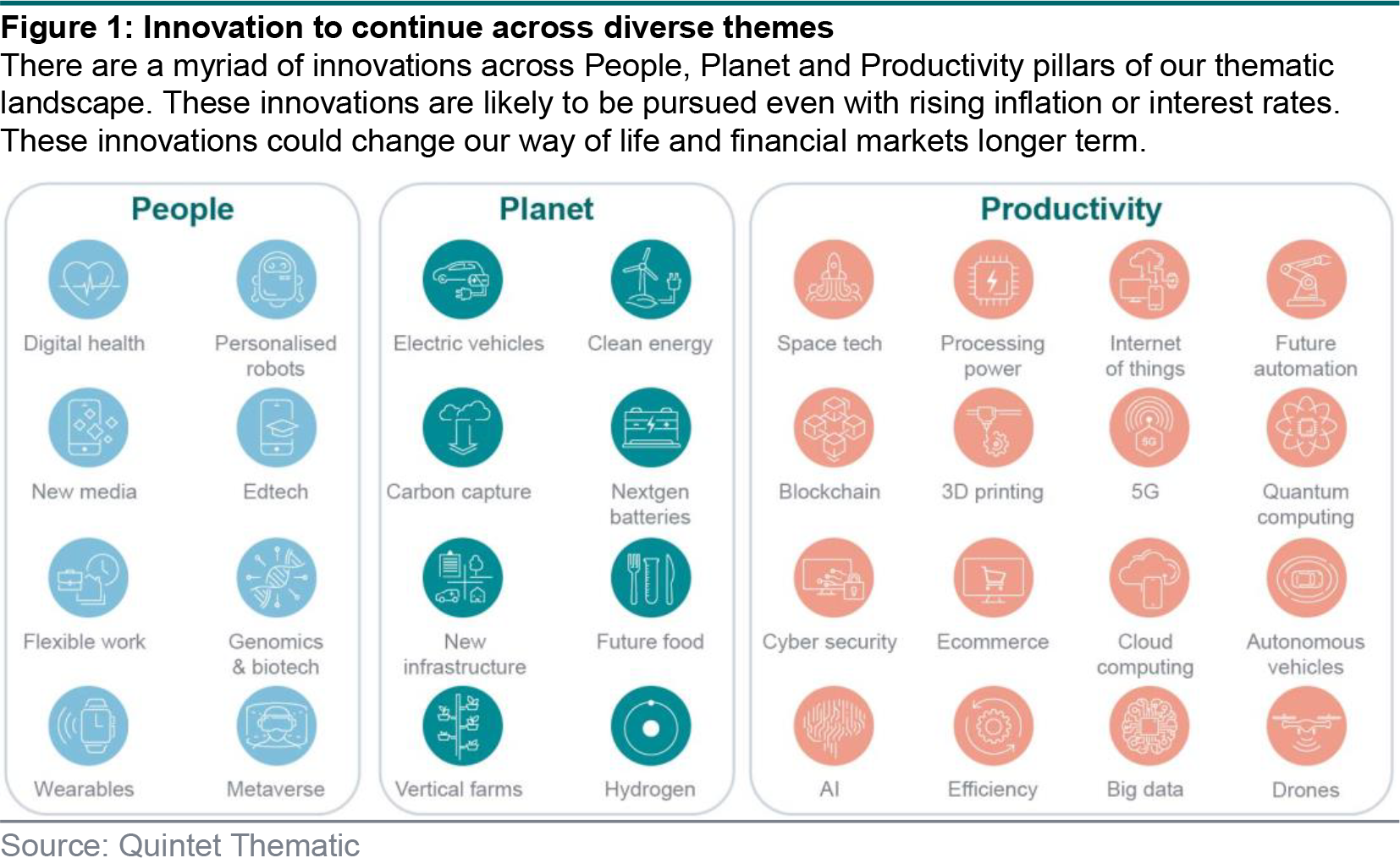
We explore three key topics: (1) the underperformance of innovation equities; (2) real world innovation trends and (3) the characteristics of quality innovative companies that could help them fare better in the current higher cost environment (e.g. those with higher margins, better pricing power and new services or products to drive growth). As overall debt remains at historically elevated levels and the savings rate normalises, the combination of high inflation and rising rates could dampen demand and impact the profits of value stocks, resulting in a quick reversal to the dominance of innovation equities, in our opinion.
Various factors caused the recent underperformance of many innovation focused equities and what could be considered speculative assets, such as cryptocurrencies (figures 2 and 3). In some cases, it’s an unwinding of the 2020 COVID trade. For example, stocks closely linked to remote life gave back a large part of their 2020 gains during 2021 as economies normalise. Beaten-down value stocks came back into favour in anticipation of the economy reopening. In some cases, especially for high-growth, unprofitable companies, rising interest rates prompted investors to reassess discount rates used in valuation frameworks. Finally, the broader market was trying to find realistic pathways of commercial success in some innovation themes and reassess the exuberance – e.g. solid state batteries, vertical farming and hydrogen.
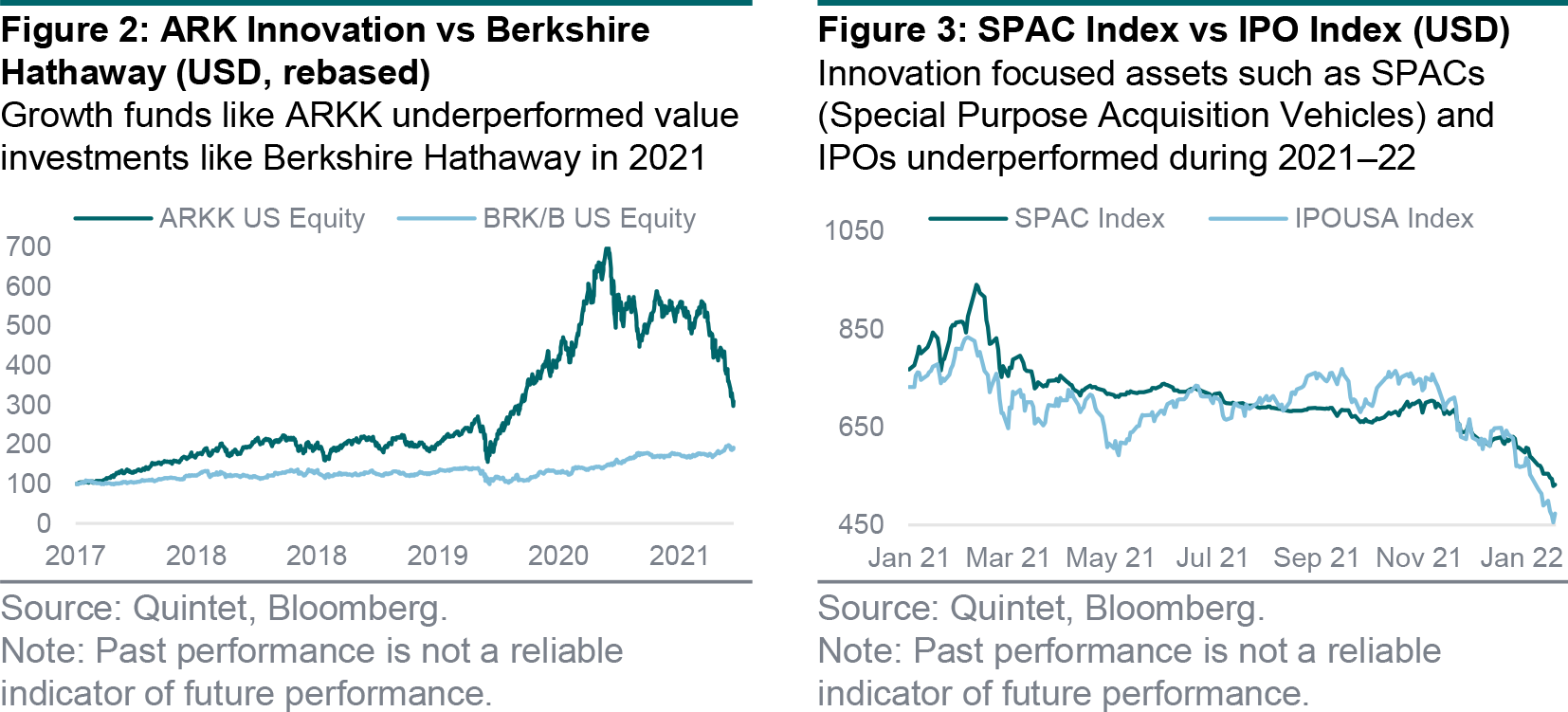
Valuation multiples have also contracted. ARK Invest, a well-known US asset manager with a specific focus on innovation, saw its flagship ARKK fund dragged down in the recent rotation. ARKK now trades at 8x EV/Sales 2023e compared with a peak of 13.4x in 2020 and average 4.7x pre COVID-19 (figure 4). Sales growth for companies in the ARKK fund (27.6% 2022e, 25% 2023e) is higher than ARKK’s pre-Covid sales growth of ~17% y-y on average during 2014–19. We are seeing a repricing of growth from arguably elevated multiples during 2020 to now more reasonable levels, especially once we consider sales growth. We believe growth itself is still robust.

We do not think innovation will stop due to a short-term rise in inflation or even if interest rates rise modestly over the longer term. It is true that the fastest period of innovation humankind has seen (since the iPhone was launched in 2007) coincided with the period of ultra-low interest rates following the 2008 global financial crisis. To some extent, ultra-low interest rates helped to pull some money into innovative start-ups amid a lack of overall economic growth. But the bigger driver of innovation over the last decade was the digitalization of the economy, enabled by technology trends such as mobile devices, cloud computing and ecommerce.
A case in point is Japan following the 1987 crash. The country also had ultra-low interest rates for decades but didn’t experience disruptive innovation on a scale anywhere near to that seen in the last decade. We believe interest rates are not as major a driver of innovation compared to other levers like technology, demographics, an entrepreneurial mindset, a savvy user base to try new services, and the structure of the economy (e.g. venture capital ecosystem).

Corporate spend data and plans also point to more investment in innovation (figures 5 and 6). Absolute levels of R&D by the top 10 US tech companies continue to rise every year, while their capex is rising too for new tech infrastructure such as data centers, smart warehouses and high- end manufacturing facilities for semiconductors, batteries and electric vehicles. This is also evident in announced projects by the big tech companies. Meta (formerly Facebook) plans to build the world’s fastest supercomputer in 2022 to power the ‘Metaverse’. Tesla is building the world’s largest automotive factory in Texas. TSMC and Intel are spending tens of billions to build the next generation of semi-conductor manufacturing facilities in the US. Investments by venture capital and start-up incubators also keep rising, boosting private capital growth (figure 7). There seems to be no obvious reason why the strong companies, especially the tech giants, would decelerate their spending and efforts to innovate.

Many modern successful companies enjoy above-market sales growth and high margins, which allows them to spend continually on innovative products and services (figure 8). This is enabled in turn by characteristics like a focus on software (e.g. Microsoft), leadership in foundational technologies (e.g. ASML), network effects (e.g. Meta and Alphabet), ecosystems (e.g. Apple), cost advantages due to scale (e.g. Amazon), market-defining innovative products and services (e.g.
Tesla and Netflix), subscription models linked to essential modern tools (e.g. Adobe) and exposure to high-growth areas (e.g. Nvidia in gaming), just to name a few.
The characteristics of successful modern companies that helped them thrive during the last decade of low inflation are also very desirable if we consider a scenario of high inflation, whether in the short or long term.
- Companies with high margins (e.g. software driven). They have less exposure to raw material or energy cost pressures. These companies will likely have more exposure to employee costs but concepts like flexible working can help them adjust more easily.
- Companies in high-growth markets. Due to demand growth, companies in high-growth areas are better able to grow sales and also increase prices if needed (e.g. Netflix and Tesla have been able to increase prices many times without any material impact on demand so far).
- Companies with market-defining products and services. Given the natural demand for market-defining products and services, pricing power is more robust for companies in this space and innovation is key for them. For example, Apple has been able to increase the prices of its flagship iPhone from around $500 in 2007 to now over $1,000. New iPhone models have benefited from multiple innovations such as faster chips and better cameras to new services, a growing service ecosystem and more apps.
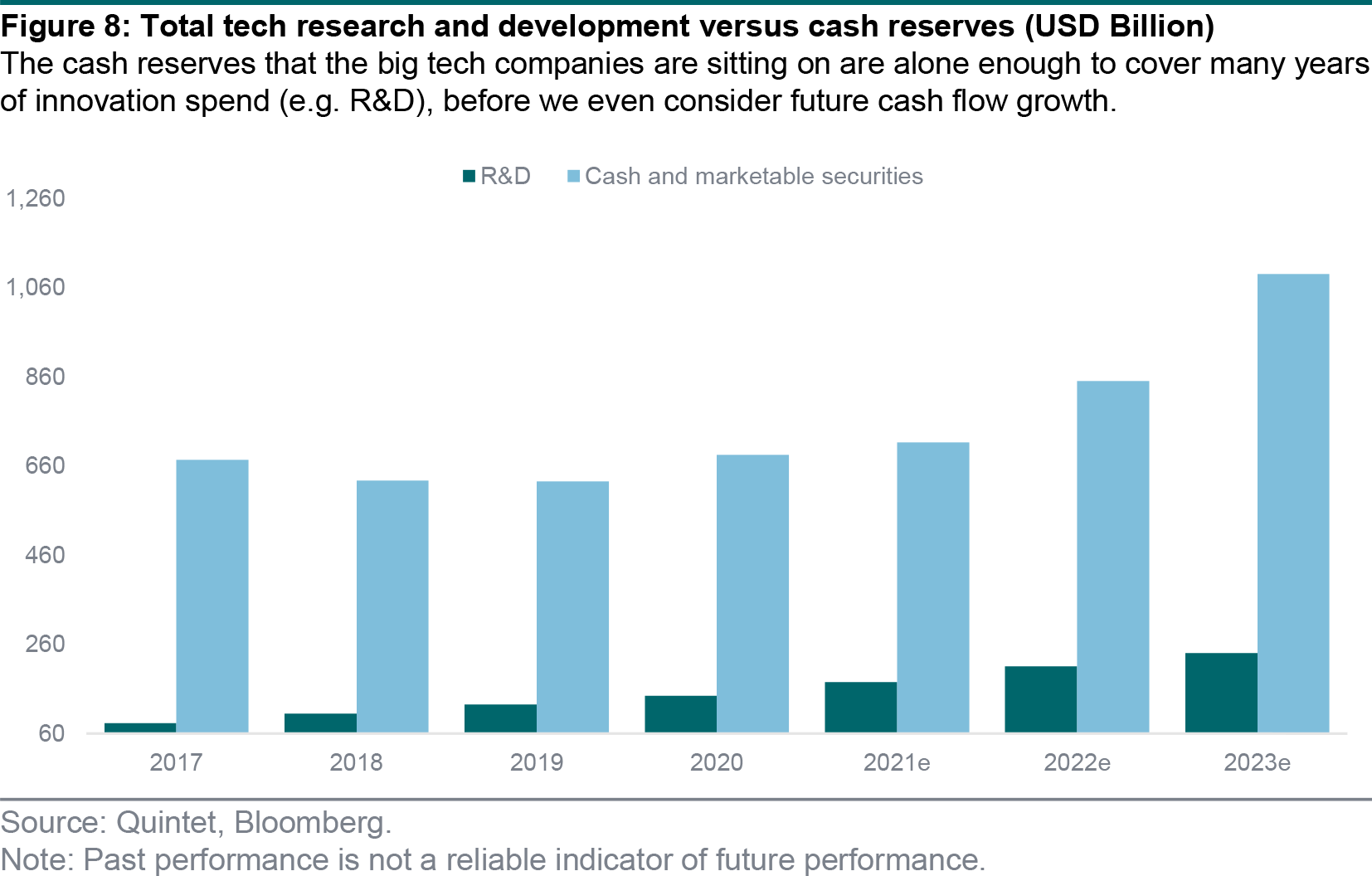
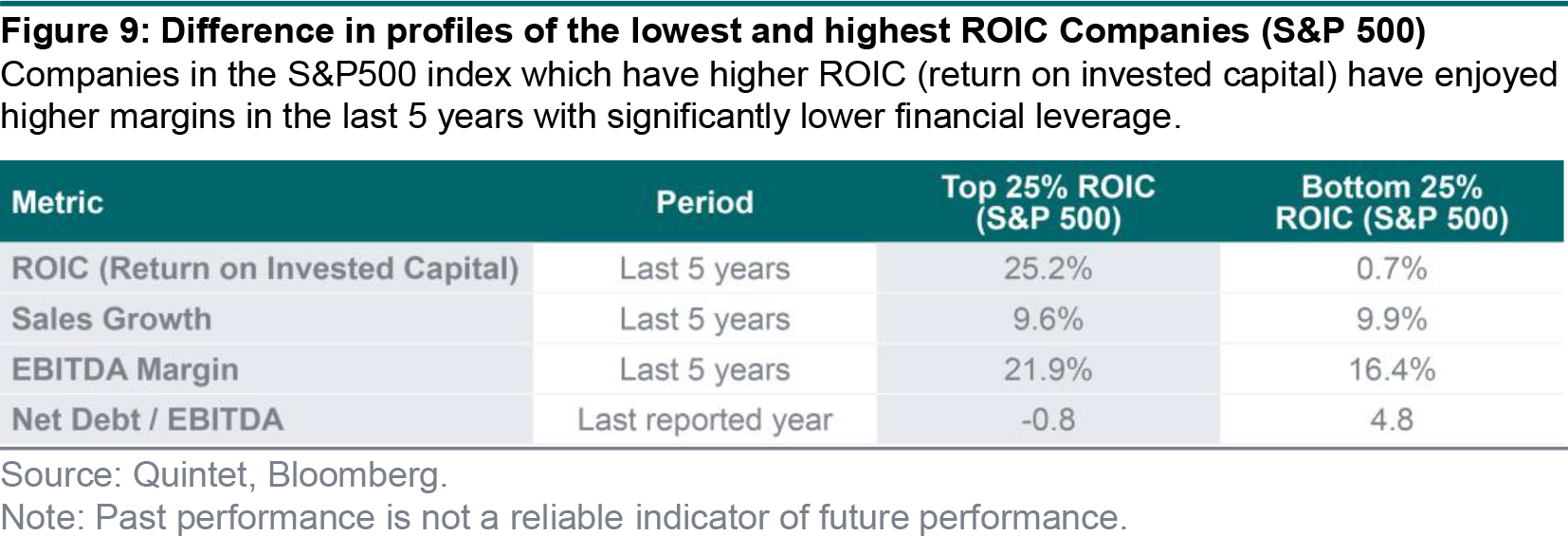
We think available funding for innovation is getting stronger, irrespective of short-term inflation. The top 10 US tech companies have over USD 600 billion in cash reserves and spend under USD 200 billion in R&D each year. These companies could keep funding current high levels of R&D without needing any debt, before we even consider the likely increase in cash flows from new services.
Even in the private space, venture investors are sitting on enormous unrealised gains from recent boom years and can continue to fund new start-ups. While start-ups can ‘burn’ cash in formative years, they are funded by equity rather than debt, making them less sensitive to interest rates.
Higher interest rates are a risk for value stocks, which tend to have less of an earnings buffer to absorb higher interest costs than innovation equities. We believe some less profitable businesses were able to survive the last decade due to near zero rates and central bank support for risky debt, without which many old economy or value stocks may have been wiped out. A potential shift to higher interest rates due to supply shocks without an accompanying strong economic growth backdrop could be a watershed moment for value stocks if some struggle to obtain access to ultra- cheap funding or find it hard to absorb higher interest costs. We believe innovation-focused companies, which tend to use net cash funding models, are less exposed to higher interest rates.
We believe old economy companies (i.e. value stocks) could have a hard time in this current high- cost environment as they may not be able to pass on costs as effectively as innovation focused companies. Given the already lower margins of old economy companies, any further margin squeeze due to cost pressures could impact their net earnings and cash flows much more negatively than that of innovation-focused companies as the latter benefit from higher margins and natural growth.
For now, the market seems to have decided that value stocks ought to be winning in a high-inflation environment (figure 9). However, we think this could be a misjudgement by the market, especially in a scenario where costs remain elevated, demand starts to weaken due to high prices and costs cannot be passed through easily. We are already starting to see some industrial companies warn on raw material cost pressures. If the economy starts to weaken, the switch back to innovation equities from value stocks could be severe and sharp, in our opinion.

In our opinion, there was some irrational exuberance whereby pockets of the markets expected all innovative companies to be as successful as Tesla or Netflix. This was evident in SPACs, meme- stocks, SaaS (software as a service), biotech and cryptocurrencies. We are bullish on innovation but we also recognise that not every innovation takes the same path to commercial success. That’s why valuing every innovative company with blue-sky scenarios can be a recipe for poor investment returns. We think the correction in the last six months is healthy which can help companies and investors focus on quality innovation rather than being a blanket boost to all hyped-up stocks.
Despite the recent jump in prices due to supply shortages, pent-up demand and policy stimulus, there are many fundamental reasons that could support disinflation in the long term: (1) robotics and automation; (2) ageing populations; (3) disruptive innovations pushing down cost curves across many economic activities; (4) virtual living which may mean less demand for physical goods; and (5) if climate change is to be addressed meaningfully, it would mean moving to a ‘lower consumption circular economy’ from the current ‘growth driven consumer economy’. To be clear, it does not need to be negative for economies and markets. A disinflationary boom is quite possible, whereby the myriad factors driving down costs also lead to innovation, growth and sustained high levels of employment, like seen in Japan or South Korea.
Thematically, in the long term, we think innovation equities look much more attractive than old economy value stocks. High prices could stifle demand in an increasingly unequal world given the pressure on consumers. Old economy companies could face the double whammy of cost pressure and worsening debt costs/access. As old economy companies start to warn, inflation could fall and interest rate rises could halt or reverse.
We are starting to see this in the world’s second-largest economy, China, where economic growth has clearly moved past the peak and looks set to settle to a slower pace as the economy rebalances and reforms (which is positive), and the central bank is cutting interest rates.
Indebtedness, whether at consumer or government level, is also at historically high levels, leaving less room for too severe interest rate hikes. Once we consider the broader long-term backdrop, especially the diverse set of disruption innovations that we think are likely this decade, we expect innovation focused companies to enjoy above-market growth and margins over the longer term.

COVID-19 is a good example of how innovation accelerates during times of turmoil. As the world went into lockdowns, people and organizations around the world adopted new digital technologies such as remote working, new media and ecommerce in ways never imagined before. Within a short period, amazing commercial progress was achieved in fields like mRNA, helping accelerate the development of vaccines in record time.
Like COVID-19, this current crisis involving higher costs and supply chain shocks could be a big driver for the adoption of new innovations. Both public companies and private markets could accelerate investment into new solutions that can help organizations as well as consumers reduce costs and increase efficiency. This new wave of innovation funding could take many forms. They include more focus on robotics and automation, more digitalization efforts, adoption of clean energy and clean mobility due to high energy costs, consumers looking for cheaper online products and solutions, and healthcare providers trying to save costs via digital health solutions.
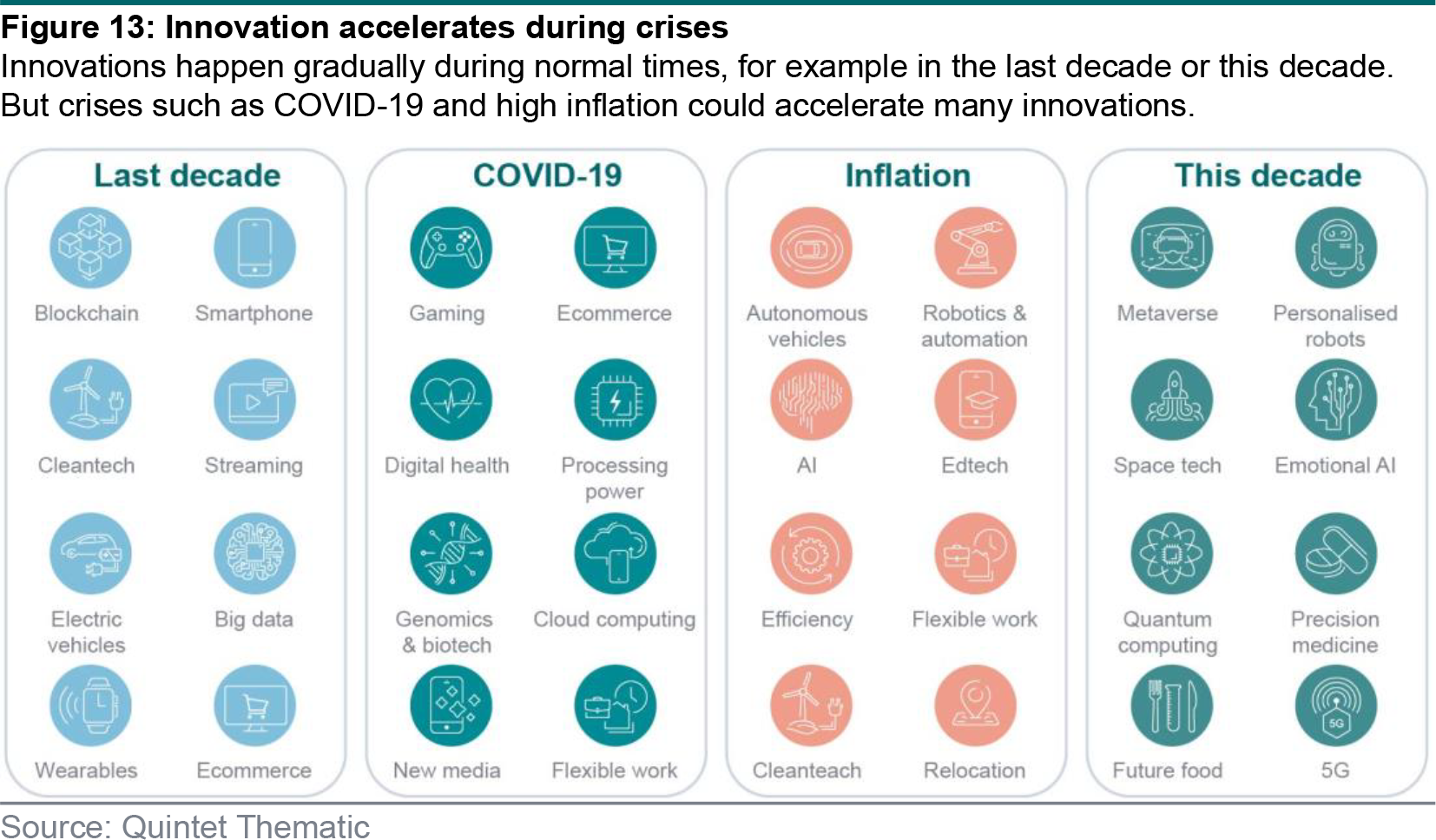
For the time being, we think it is prudent to focus on S-curve themes over Moonshot themes. S- curve themes are those where the technologies are known to be commercially successful (e.g. cloud computing and cybersecurity) but we are still at the early stages of penetration and market growth. Moonshot themes, on the other hand, could be very impactful and profitable if successful but commercial success is not yet proven or certain (e.g. quantum computing). Typically S-curve themes have better earnings visibility than Moonshot themes – this is a good characteristic to have in the near term as the market tries to digest all the moves in inflation and interest rates.
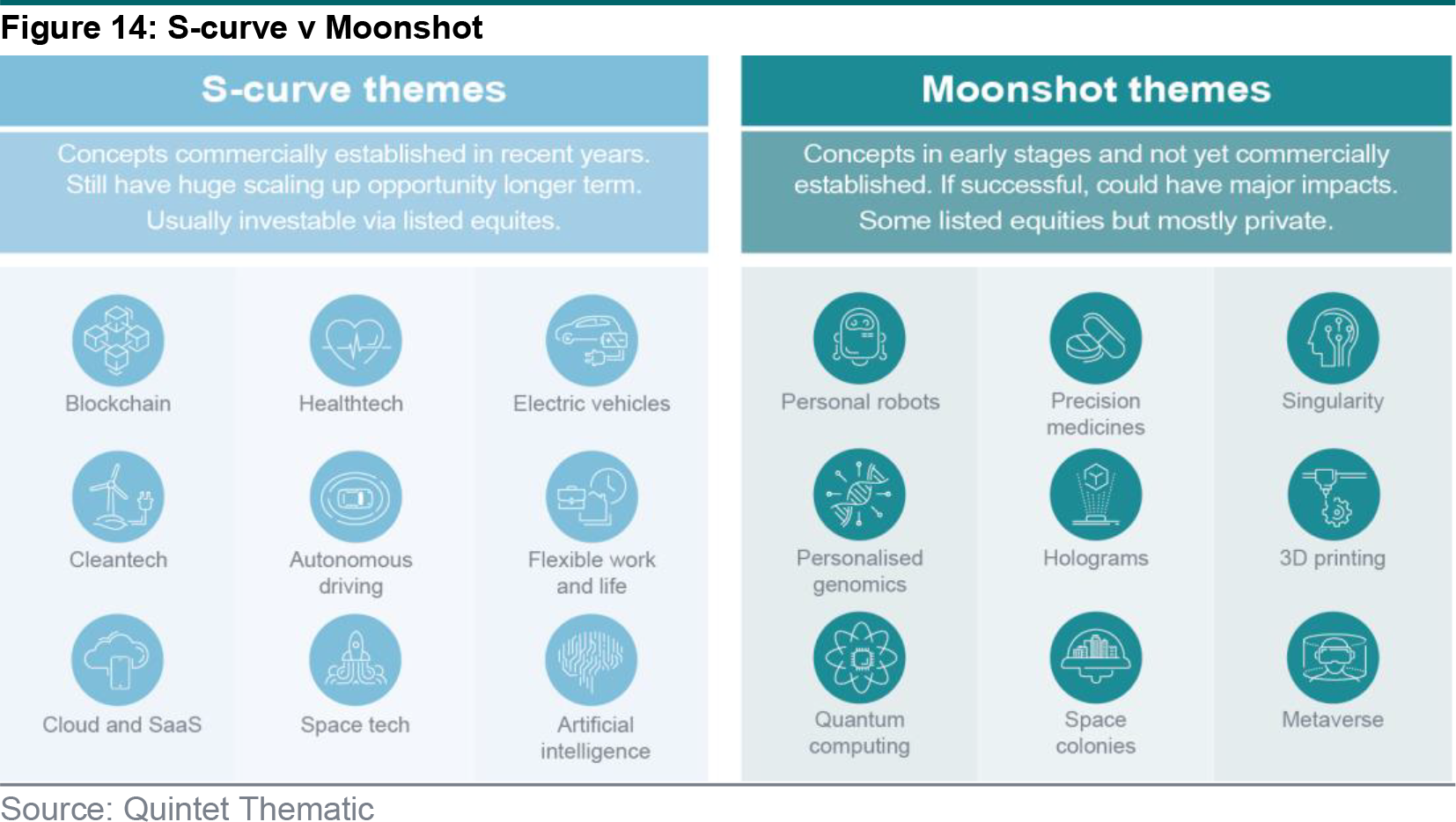
You can find out more about our views for the year ahead in Counterpoint 2022. Our investment experts share their views on financial markets and investing, as well as the themes we think will drive tomorrow’s economy – from sustainability issues and the fight to mitigate climate change to the ongoing digitalisation of many aspects of our lives.
Authors:
- Pinaki Das Head of Thematic Research
- Daniele Antonucci Chief Economist & Macro Strategist
- Kenneth Warnock Head of Direct Equities
- Adam Lavelle Equity analyst
- James Purcell Group Head of Sustainable Investment
- Bill Street Group Chief Investment Officer
This document has been prepared by Quintet Private Bank (Europe) S.A. The statements and views expressed in this document – based upon information from sources believed to be reliable – are those of Quintet Private Bank (Europe) S.A. as of 7 February 2022, and are subject to change. This document is of a general nature and does not constitute legal, accounting, tax or investment advice. All investors should keep in mind that past performance is no indication of future performance, and that the value of investments may go up or down. Changes in exchange rates may also cause the value of underlying investments to go up or down.
Copyright © Quintet Private Bank (Europe) S.A. 2022. All rights reserved.






